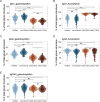Parasitic infections during pregnancy in Gabon affect glycosylation patterns of maternal and child antibodies
- PMID: 39738418
- PMCID: PMC11685704
- DOI: 10.1038/s41598-024-83366-8
Parasitic infections during pregnancy in Gabon affect glycosylation patterns of maternal and child antibodies
Abstract
Antibody glycosylation patterns can affect antibody functionality and thereby contribute to protection against invading pathogens. During pregnancy, maternal antibodies can be transferred through the placenta and contribute to modulating both the mother's and her child's immune responses. Although several studies of IgG glycosylation during pregnancy have been carried out, very few cohorts studied were from sub-Saharan Africa, where exposure to microorganisms and parasites is high. In Lambaréné, Gabon, 106 pregnant women in their third trimester were enrolled into this study. At enrolment, urine, stool, and blood samples were collected from the mothers to assess Schistosoma haematobium (S. haematobium), Plasmodium falciparum (P. falciparum) and other parasite infections. During delivery, cord blood samples were collected. The children were followed, and blood samples were collected at 9 and 12 months of age. IgG Fc glycosylation was measured by liquid chromatography-mass spectrometry, determining fucosylation, galactosylation, sialylation, bisection, and sialylation per galactose (SA/gal). Among the 106 pregnant women, 33 (31%) were infected by at least one parasite. The antibody glycosylation patterns in maternal and cord blood showed distinct profiles when compared to that of infants at 9 and 12 months. IgG galactosylation was higher in maternal/cord blood, while fucosylated IgG was higher in children up to 1 year of age. Maternal parasitic infection was associated with lower IgG2 and IgG3/IgG4 galactosylation in cord blood and lower IgG3/IgG4 galactosylation in children. When maternal IgG galactosylation and, consequently, cord blood were categorized as high, children at 9 and 12 months of age showed higher IgG galactosylation compared to children of mothers with low IgG galactosylation. As IgG Fc galactosylation can have functional consequences, it might provide valuable information for developing effective preventive and treatment strategies for vulnerable populations.
Keywords: Antibody; Child; Gabon; Glycosylation; Parasitic infections; Pregnancy.
© 2024. The Author(s).
Conflict of interest statement
Declarations. Competing interests: The authors declare no competing interests. Ethical consideration: All participants gave their written informed consent before their inclusion in the study. The study was conducted in accordance with the Declaration of Helsinki and was approved by the Institutional Ethical Committee of the CERMEL (CEI-CERMEL Nº13/2013). Statistical consideration: The principal component analysis was performed on all available antibody glycosylation data measured in this study. As variables, we included the main derived traits on the different IgG isotypes, namely galactosylation, bisection, fucosylation and sialylation of IgG1, IgG2 and IgG3/IgG4. Lastly, these variables were scaled to unit variance. The percentage of glycan structures between samples was compared using an unmatched two-sample Wilcoxon test. The identified low/medium/high group of glycosylation for the different traits was based on splitting the values into three equal-sized quantiles for each sample type. To compare these quantiles over time, each sample origin (cord blood, child 9 months, child 12 months) was compared to the mother with Fischer’s exact test for a 3 × 3 table. Using the ‘stats’ package, the statistical test was performed in R (4.3.1), and p-values < 0.05 were considered statistically significant.
Figures





References
-
- Honkpehedji, Y. J. et al. Association of low birth weight and polyparasitic infection during pregnancy in Lambarene Gabon. Trop. Med. Int. Health26, 973–981. 10.1111/tmi.13591 (2021). - PubMed
-
- Adegnika, A. A. et al. Epidemiology of parasitic co-infections during pregnancy in Lambarene Gabon. Trop. Med. Int. Health15, 1204–1209. 10.1111/j.1365-3156.2010.02598.x (2010). - PubMed
Publication types
MeSH terms
Substances
Grants and funding
- 01KA1307/German Federal Ministry of Education and Research (BMBF)
- 01KA1307/German Federal Ministry of Education and Research (BMBF)
- 2015-1045/European and Developing Countries Clinical Trials Partnership
- 101080784/European Health and Digital Executive Agency
- SPI.2021.004/Dutch Research Council (NWO)
LinkOut - more resources
Full Text Sources
Research Materials

